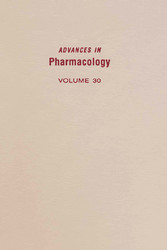Suchen und Finden
Service
Advances in Pharmacology
J. Thomas August, M. W. Anders, Ferid Murad (Eds.)
Verlag Elsevier Textbooks, 1994
ISBN 9780080581224 , 399 Seiten
Format PDF
Kopierschutz DRM
Geräte
Front Cover
1
Advances in Pharmacology, Volume 30
4
Copyright Page
5
Contents
6
Contributors
10
Chapter 1. Neuroprotective Actions of Excitatory Amino Acid Receptor Antagonists
14
I. Introduction
14
II. Glutamate Receptor Subtypes
15
III. Excitotoxicity and Glutamate
22
IV. Ischemia
26
V. Prospects for Clinical Application
29
VI. Molecular Events Associated with Neuroprotection
32
VII. Conclusions
34
References
34
Chapter 2. Pharmacologic Therapy of Obsessive Compulsive Disorder
48
I. Clinical Features of Obsessive Compulsive Disorder
48
II. Biology of OCD
51
III. Pharmacologic Treatment of OCD
52
IV. Summary
60
References
61
Chapter 3. Mechanism of Action of Antibiotics in Chronic Pulmonary Pseudomonas Infection
66
I. Introduction
66
II. Bacterial Biofilms
67
III. Pseudomonas aeruginosa in Cystic Fibrosis
71
IV. Antibiotic Therapy of Intermittent and Chronic Pseudomonas aeruginosa Infection in Cystic Fibrosis
80
V. Conclusions
88
References
88
Chapter 4. Quinolinic Acid in Neurological Disease: Opportunities for Novel Drug Discovery
98
I. General Properties of Quinolinic Acid
98
II. Neurotoxicity of Quinolinic Acid
99
III. Pathways for Quinolinic Acid Biosynthesis
104
IV. Sites of Control of Quinolinic Acid Biosynthesis
110
V. Studies on Quinolinate in Vivo
113
VI. lnhibitors of Quinolinic Acid Biosynthesis
128
VII. Implications for Drug Discovery
130
References
131
Chapter 5. Pharmacologic Management of Shock-Induced Renal Dysfunction
142
I. Introduction to Shock
142
II. Spectrum of Renal Dysfunction in Shock
146
III. Pathophysiology of Acute Renal Failure in Shock
149
IV. Pharmacologic Measures
162
V. Conclusion
190
References
191
Chapter 6. Autoantibodies against Cytochromes P450: Role in Human Diseases
212
I. Introduction
212
II. Diseases for Which No Causative Toxin Was Identified
213
III. Diseases for Which a Causative Drug Has Been Identified
220
IV. Hypotheses for the Appearance and Role of Anti-P450 Autoantibodies
245
V. Conclusions
247
References
249
Chapter 7. Activation and Inactivation of Gene Expression Using RNA Sequences
260
I. Introduction
260
II. Examples of RNA-Mediated Gene Regulation
261
III. Pharmacological Applications of RNAs
267
IV. Concluding Remarks
275
References
275
Chapter 8. Therapy of Cancer Metastasis by Systemic Activation of Macrophages
284
I. Introduction
284
II. Cancer Metastasis
285
III. Macrophages and Homeostasis
287
IV. Tumoricidal Activation of Macrophages
288
V. Macrophage–Tumor Cell Interaction
290
VI. Mechanisms for Macrophage Recognition of Tumor Cells
292
VII. Systemic Activation of Macrophages by Liposomes Containing Immunomodulators
295
VIII. Macrophage Infiltration into Tumors
301
IX. Therapy of Cancer Metastasis in Murine Models
302
X. Optimization and Limitations of Systemic Macrophage Activation-Based Therapy
304
XI. Potentiation of Macrophage Activation for Treatment of Cancer Metastases with Liposome-Encapsulated Agents
306
XII. Multimodality Treatment of Lung Metastases in Murine Models
309
XIII. Therapy of Spontaneous Lung Metastases in Dogs with Osteogenic Sarcoma
312
XIV. Clinical Studies
313
XV. The Place of Macrophage Systemic Activation in Multimodality Protocols
322
XVI. Conclusions
324
References
325
Chapter 9. 5-Hydroxytryptamine Receptor Subtypes: Molecular and Functional Diversity
340
I. Introduction
340
II. G-Protein-Coupled 5-HT Receptors
344
III. 5-HT-Gated Ion Channels-5-HT3 Receptors
376
IV. Conclusion
379
References
380
Index
394
Contents of Previous Volumes
402
Service
Shop



